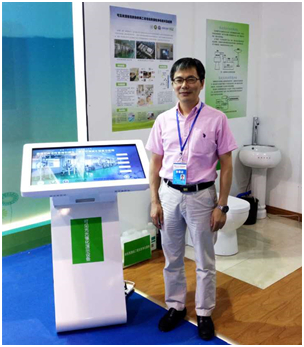Professor Wenbin CAO's research project is showcased during the National "12th five-year plan" Scientific and Technological Innovation Achievement Exhibition
With the theme of "Using development, science and technology for an innovative future" the National "12th five-year plan" Scientific and Technological Innovation Achievements Exhibition was held from June 1st to June 7th at the Beijing Exhibition Center. Through a comprehensive evaluation of the participants' work, the exhibition recognized some the most important achievements in science and technology made in China in the last few years.

Representing the only participant in the exhibition of science and technology projects, Professor Wenbin CAO from the School of Materials Science and Engineering of USTB, led his team to exhibit the preparation and application techniques of nitrogen-doped titanium dioxide nanoparticles which achieve ground breaking results.

Along with economic development and people's living standards improvement, environmental stewardship stands as one of the most pressing issues affecting quality of life in China. By acting as a chemical catalyst to convert visible light into chemical energy, nitrogen-doped titanium dioxide nanoparticles can help with bacteria elimination, air pollutants purification and the decomposition of organic gaseous pollutants such as formaldehyde. Therefore, it is recognized as one of the best photocatalytic materials to combat indoor and outdoor air pollution. The pilot production of N-TiO2 will bring great economic and social benefit.

Accordingly, USTB's Department of Inorganic Nonmetallic Materials, led by Professor CAO and in cooperation with our partners the Beijing Institute of Technology, the PLA 306 Hospital, Shandong Yikang Environmental Company and Bejing New Building Material Group have all partnered to conduct more than 10 years' worth of research in the preparation and application of nitrogen-doped titanium dioxide nanoparticles.

Headquarters for the largest research and development center for photocatalytic production
Supported by The National Natural Science Fund and the Ministry of Science and Technology's National High - Tech Research and Development Program of China (863 Program) Professor Cao's project has made three crucial breakthroughs:
1.Obtained independent intellectual property rights of the low-cost large scale preparation of nano-photocatalytic materials. This included developing a series of photocatalytic products and applying for 12 Chinese invention patents (with 7 already licensed), leading to the drafting of one national standard and the creation of the first global Nano-photocatalytic material N-TiO2 hundred-ton model line. Accordingly, the standardized production base was built on an area of 100 acres and has passed the ISO9001 quality management system certification.

Production line of the first global hundred-ton visible light photocatalytic environmental purification stations
2.Built China's first functioning photocatalytic demonstration area in Linyi city, Shandong Province. With the cooperation of the city of Linyi, the photocatalyst was applied in various local primary and secondary schools, kindergartens, hospitals, workplaces and communities. Following the trial, results by the Center for Disease Control and Environmental Protection Agency of Linyi city showed that the product had good practical effects, reducing various organic gaseous pollutants. Additionally, the photocatalyst was also shown to compliment pre-existing construction materials, enhancing the building’s original structure and allowing for the development of new antibacterial and self-cleansing materials.

The first Professional Photocatalytic Science Museum in China
3.Built China's first Professional Photocatalytic Science Museum. With the support and assistance of the Photocatalysis Industry Association of China, the museum was built in the city of Linyi and has an area of 700 square meters, making it China's first and the world's largest photocatalytic museum. At the museum itself, visitors can learn more about photocatalytic scientific principles, the practical application of the technology and its effectiveness in environmental purification.

Technology is changing life, and with the environmental purification progress made with photocatalysts, we can look forward to more blue skies and cleaner water!


